Stonehenge Sun & Star Observatory in Astrology. Astrology and astrogeography of sacred and magical places: the astrogeographical position of Stonehenge
Astrogeographical positions of important sites related or comparable to Stonehenge:
- Göbekli Tepe in Capricorn – Scorpio
- Cromleque of Almendres in Sagittarius – Taurus/Gemini
- Sun Observatory of Goseck in Virgo – Pisces
- “American Stonehenge” in Sagittarius – Gemini
- Avebury in Taurus – Cancer
- Woodhenge in Virgo – Libra/Scorpio
- Stanton Drew in Scorpio – Aquarius
- Sillbury Hill in Aquarius/Pisces – Aries
Related articles: The 11.000 year old Temples & Gathering Sites of Göbekli Tepe, Pyramids of Giza in astrology, The 7000 year old Sun Observatory of Goseck in astrology. Sagittarius in Astrogeography, Gemini in astrogeography, Glastonbury Abbey, Saint Michael Leyline in Astrogeography, Saint Michael`s Mount and Mont Saint Michel in Sagittarius, Avebury Stone Circle, The Hill of Tara, British Kings & Queens in astrogeography, Dolmen and Portal Tombs in astrogeography, Nabta Playa sun and star observatory, Capitals of World Religions in Astrology, London and Great Britain in Political Astrology, Hill of Uisneach
Stonehenge Sun & Star Observatory in Astrology
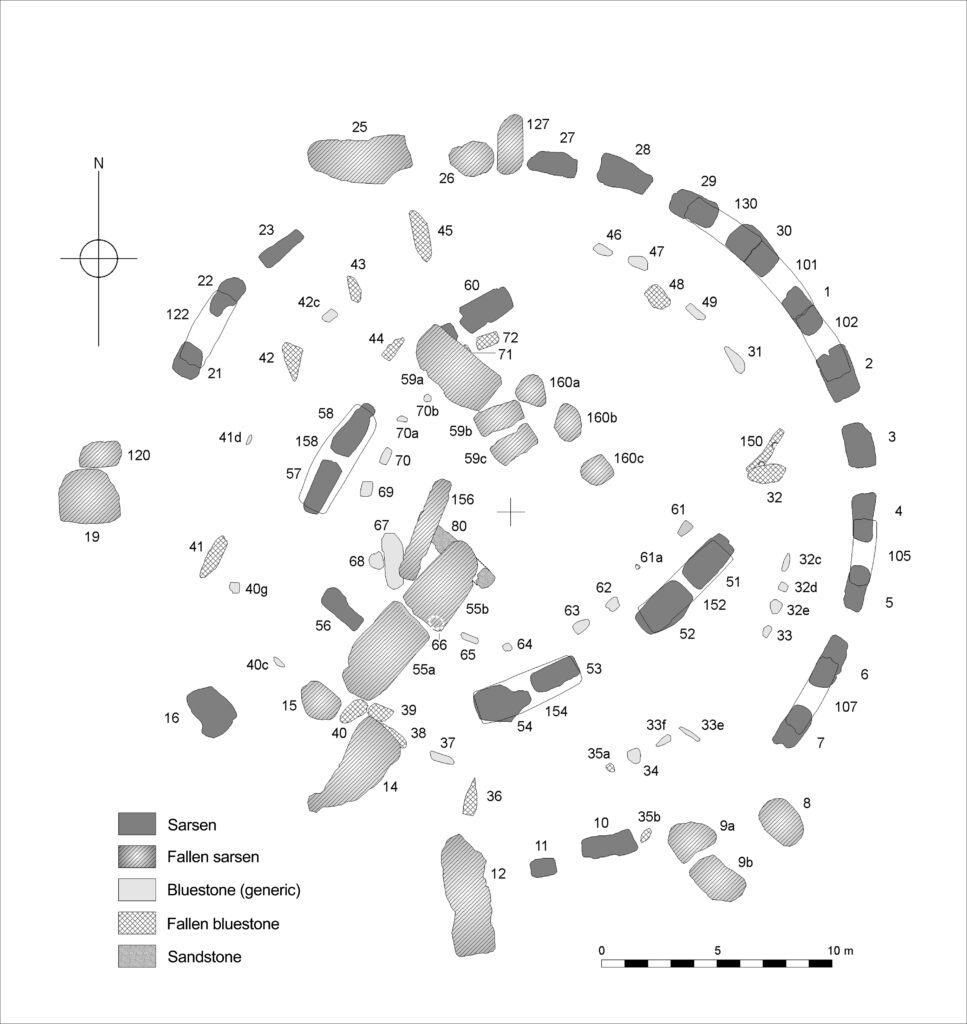
The sun observatory and temple of Stonehenge is according to my astrogeographical worldmap calculation system located in Sagittarius with Gemini. The astrogeographical position describes it as a university for shamanistic initiation (Sagittarius) as well as an or educational center (Gemini) of architecture and astronomy knowledge and a sun, moon and star observatory (Sagittarius).
It is one of the best – explored pre-historical buildings and it´s historical importance as an elaborate stone monument may be compared to a link between the circular temples of Göbekli Tepe Temple (9000 BCE) and the Pantheon building in Rome…
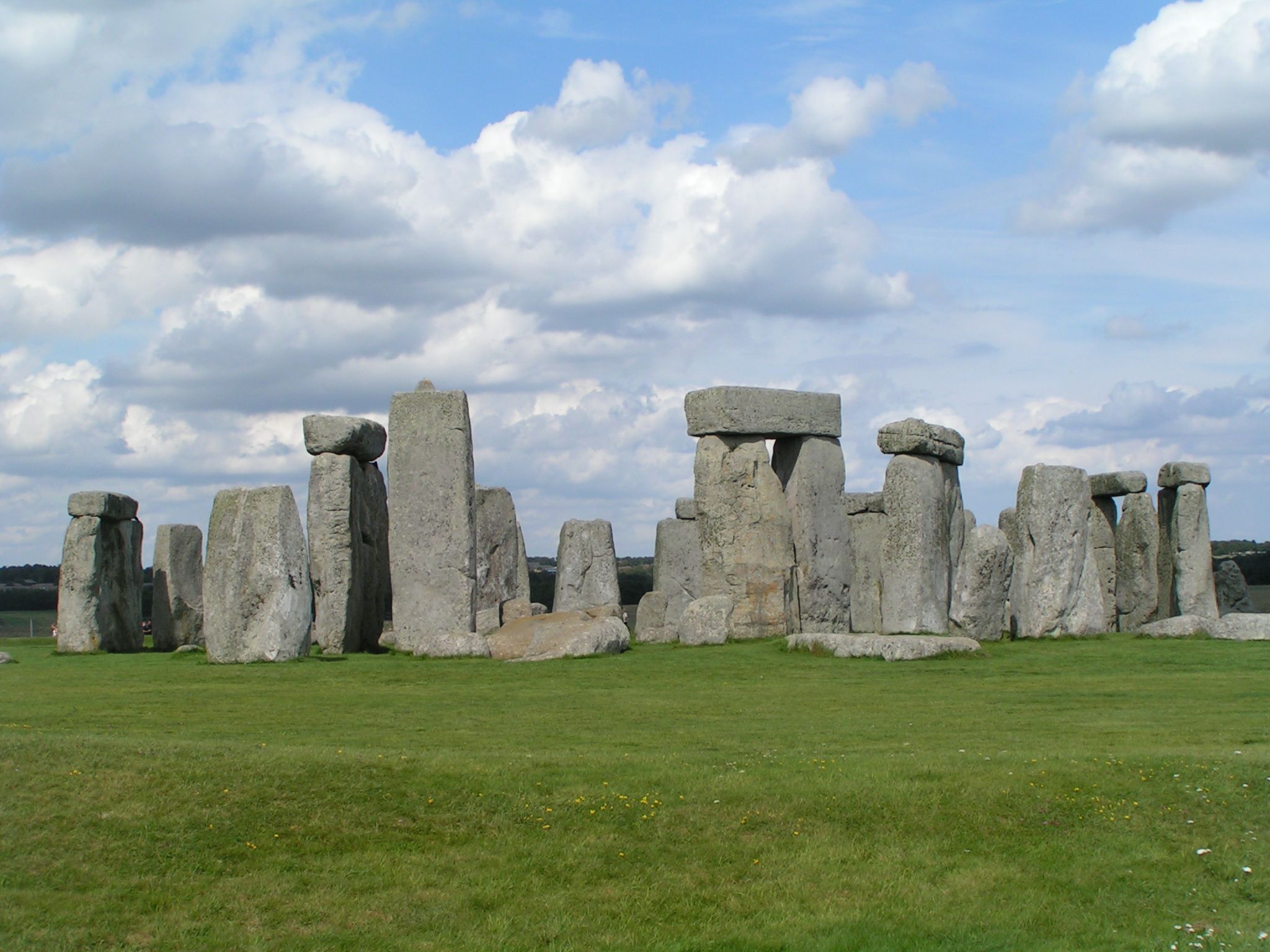
The alignment of the stones is such that on the morning of the summer solstice (21.6.) the Sun rises directly over the so called “Heel Stone” with its rays beaming in a direct line from there to the very center of the stone circle. Despite all other functions of the Stonehenge circle this is a clear evidence for it being built as calendar building in order to determine eclipse, solstice, equinox and other celestial events that were important for calculating the best days for sowing in early agricultural societies. Numerous similar buildings made from wood dating back as far as 5000 BC have been found in particularly fertile regions of Europe. But none of them was built for eternity and with such effort as Stonehenge..
Period of Construction:
Dating of the construction & development process of Stonehenge:
Stonehenge was not the first sun and star observatory built on earth. And it was not the first one built using stones either. Nabta Playa and Cromleque of Almendres (both ca. 5000 BCE) are far older. Not to speak of the 12.000 (or more) years old round-temples of Göbekli Tepe where installations for observation of solar stations and day time cannot and should not be excluded.
I suggest to explore how the uniqueness and importance of Stonehenge might be found to lie in:
- its monumentality – quantitative dimensions in size, labour, weight of stones
- its function as an attempt to consolidate, stabilize, preserve and teach astronomical knowledge
- its potential function to as a monument to local, native culture and identification as a signpost & symbol (Gemini) of homeland
- its potential function as a super-building aimed at uniting local tribes and poluations under one (tribal ?) state cult
- therefore as an attempt to lay a foundation for some sort of stabilization of “local or even “national” inheritance
Astrological evaluation of astrological ages and the time quality of the construction period.
For assignment of the different stages in the development prcoses to Astrological Ages I suggest to explore and understand the transits defined by the slowest moving 3 of the12 systemical astrological planets Pluto, Neptune, Uranus and the Great Mutations cycles of conjunctions of saturn and Jupiter.
- Pluto – Neptune Cycles & Super-Cycles – duration: ca. 33.000 terrestrial years
- Pluto – Neptune Conjunction-Cycles – duration: 495 terrestrial years
- Pluto Years – duration: 248 terrestrial years
- Uranus – Neptune Conjunction-Cycles – duration: 171/172 terrestrial years
- Great Mutation Conjunctions of Saturn & Jupiter Cycles – duration: 119 – 238 terrestrial years
- Neptune Years – duration: 164 terrestrial years
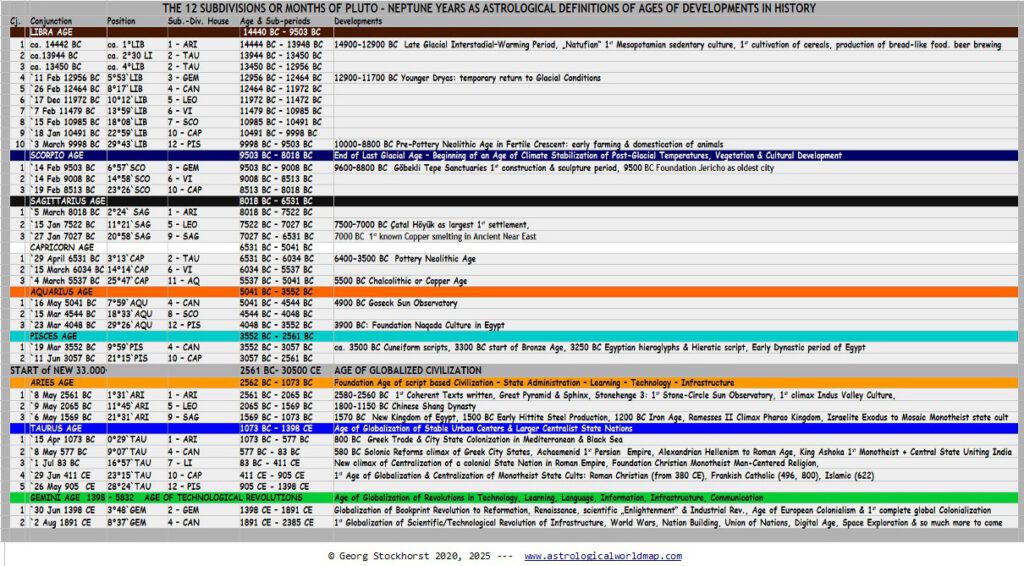
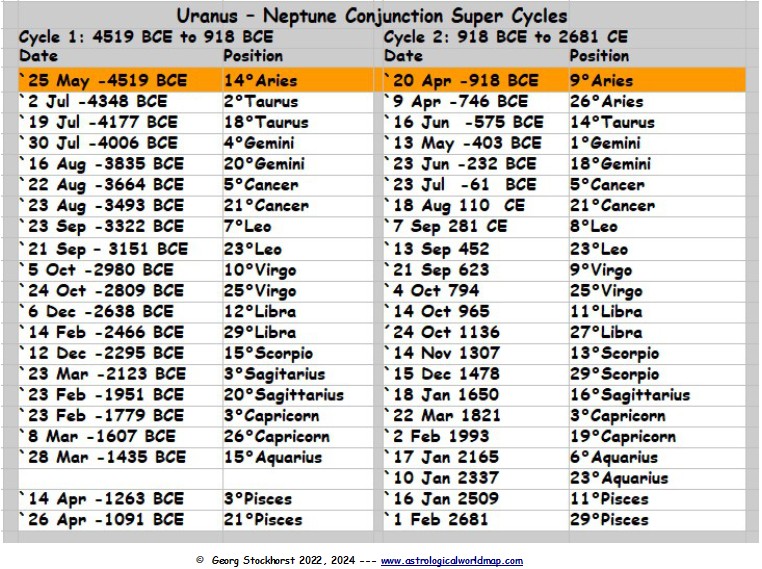
Chronology of Construction of Stonehenge with Astrological Ages
An answer to the question at when or at which stage of the commonly defined periods E 2 to 3 the henge was expanded to a stone built sun observatory could be most interesting for astrological evaluation of the timing of its construction process.
- A —- 3100 BCE – Beginning of the construction work
- B —- 3100 BCE to 1500 BCE: overall period of construction: PL-NE CC: House 8 -12/Pisces Age–Aries Age–House 1/Taurus Age –— NE-UR CC: Leo Age I to Capricorn Age II
- C —- Stonehenge 1: 3100 – 2900 BCE : PL-NE CC: House 9 to 10 / Pisces Age, UR-NE CC: Leo Age II to Virgo Age I
- C —- Circular 110 m diameter bank and ditch enclosure made of Late Cretaceous Seaford chalk, with large north entrance and smaller one tsouth” (source: wikipedia article)
- D —-Stonehenge 2: 2900 – 2600 BCE: PL-NE CC: House 10 to 12 /Pisces Age; UR-NE CC: Virgo Age I to Libra Age I
- D —- “A timber structure was built within the enclosure….Further standing timbers were placed at the northeast entrance, and a parallel alignment of posts ran inwards from the southern entrance.” (wikipedia article)
The stone-made observatory period of Stonehenge began with Stonehenge 3. Until then the wooden observatories for determining agricultural dates had a 2000 thousand year or even longer tradition in Europe.
- E —- Stonehenge 3: 2600 – 1600 BCE: PL-NE CC: House 12 /Pisces Age to House 9 /Aries Age; UR-NE CC: Libra Age I to Capricorn II
- E 1 — Stonehenge 3 I: 2600 Shift to use of stone instead of timber: beginning of new 33.000 years super cycle
- E 1 — The builders ….dug two concentric arrays of holes (the Q and R Holes) in the centre of the site. … The holes held up to 80 standing stones (shown blue on the plan), only 43 of which can be traced today..
- E 2 — Stonehenge 3 II 2600 – 2400 BCE: PL-NE CC: House 12/Pisces Age to House/Aries Age; UR-NE CC: Libra Age I to II
- E 2 — “30 enormous Oligocene–Miocene sarsen stones (shown grey on the plan) were brought to the site….. The stones were dressed and fashioned with mortise and tenon joints before 30 sarsens were erected in a circle of standing stones approximately 98 feet (30 m) in diameter, with a ring of 30 lintel stones resting on top. The lintels were fitted to one another using tongue and groove joints – a woodworking method, again. Each standing stone was around 4.11 m high, 2.13 m wide, and 1.06 m deep, weighing around 26 tons.” (wikipedia article)
- E 3 — Stonehenge 3 III 2400 – 2280 BCE: PL-NE CC: House 2 to 3 of Aries Age; UR-NE CC: Libra Age II to Scorpio I
- E 3 — “… bluestones appear to have been re-erected…”
- E 4 — Stonehenge 3 IV 2280 – 1930 BCE: PL-NE CC: House 3 to 5 of Aries Age; UR-NE CC: Scorpio Age I to Sagittarius II
- E 4 — “…. the bluestones… were arranged in a circle between the two rings of sarsens and in an oval at the centre of the inner ring”
- E 5 — Stonehenge 3 V 1930 – 1600 BCE: PL-NE CC:: House 5 to 9 of Aries Age; UR-NE CC: Sagittarius Age 2 to Capricorn II
- E 5 — “….the northeastern section of the Phase 3 IV bluestone circle was removed, creating a horseshoe-shaped setting (the Bluestone Horseshoe) which mirrored the shape of the central sarsen Trilithons…” (wikipedia article)

Stonehenge at the Beginning of the AGE OF MODERN CIVILIZATION
- The year 2561 BCE marked the beginning of a new 33.000 years super cycle of Neptune – Pluto conjunctions.
- The coincidence with the beginning of Stonehenge 3 when stones were first used to stabilize the marks ste for determination of calendar dates EXPLAINS STONEHENGE AS A BRITISH EQUIVALENT TO EGYPTS PYRAMIDS OF GIZA.
- The years around 2500 BCE mark the beginning of the “AGE OF MODERN CIVILIZATION” with important breakthroughs like the development of elaborate script. in the Fertile Crescent, Egypt and possibly the Indus Valley culture too.
- The Neptune-Pluto Conjunction Cycle reaching 0°Aries in 2561 BCE and the OPPOSITION DEGREE (0°LIBRA) to the BEGINNING OF THE GLACIAL WARMING PERIOD in 9503 BCE explains how cultural development on earth passed into A NEW AGE at that moment in time.
- This cyclic resonance of Stonehenge allows direct comparison of Stoneheng with the “MOTHER OF ALL TEMPLES” and probably “CALENDAR BUILDINGS” too at Göbekli Tepe.
Astrogeographical resonance positions:
Field Level 1 (greater region, global resonance): 9°Capricorn and 1°Scorpio
- Resonance coordinates of Stonehenge for field level 1 are 9° in solid, conservative earth sign Capricorn and 1° in solid, fixed water sign Scorpio..
- To start with there is a resonance with the astrogeographical positions of the 7000 years older “Mother of all Stone-Masonry Temples” at Göbekli Tepe (located in Scorpio-Capricorn) included in this aspect.
Field Level 3 (surrounding area, field size: 1 km x 1.4 km):
- Position for astrogeographical field level 3 (surrounding area) which explains the energetical topics of the site and how it is embedded in the land.: The site is located in the sign combination of air sign Gemini with fire sign Sagittarius.
- The fact that Gemini and Sagittarius are to be seen as the signs of learning, education (Gem) and understanding (Sag) could mean that Stonehenge was built to conserve and pass on knowledge in the first place.
- Gemini and Sagittarius define opposite positions in the Sun`s yearly path marking the periods before the summer solstice (21.6. = 30° Gemini) and the winter solstice (21.12. = 30° Sagittarius). This can be evaluated as a possible indication that the astrogeographical resomnance of the site reflects the particular importance as a calendar building constructed to measure (and celebrate) the solstice days.
- While Gemini the sign of schools stands for passing information and knowledge Sagittarius as the sign of the priest castes resonates with the topic of an initiation site in megalithic shamanic (druid) cultures.
- Sagittarius being present here, is a hint to the importance of this astrological archetype for the awareness of the chronological order of time and for time measurement in general.
- This is because Sagittarius (the holder of the bow) through its relation to arcs and circles in general also brings up the mental awareness about cycles.
- It can also be concluded that the archer`s tool – the bow – is more than a just a weapon for hunting and shooting. It is also a sextant to measure out directions though heavenly and earthly distances.
- In my systematical astrogeomantic field studies I have observed really many round-shaped buildings (and circles) being situated in Sagittarius. Round forms are a clear indication for a place having at least one of two coordinates in this sign.
- Apart from these considerations it is obvious that Stonehenge has been used as a temple site during its long history even though the astrogeographical coordinates do not particularly point out that this has been the central motif for its construction.
- I want to suggest, that especially because of the presence of the sign of Sagittarius, Stonehenge should be seen as ann instrument for time measurement, with of course all the mystical as well as magical (practical) impact of what time itself and it´s measurement can mean to humans.
- As for the forms of worship, the fire sign of Sagittarius may hint at the probability of the function of the site for fire sacrifices, cremation, ritualistic worship and initiations here.
The example of the sun clock & observatory of the Pantheon in Rome located in Sagittarius with Cancer
And of the most important classical examples for such type of round buildings that were used as observatories and are located in Sagittarius that served time-measurement is the Pantheon in Rome.
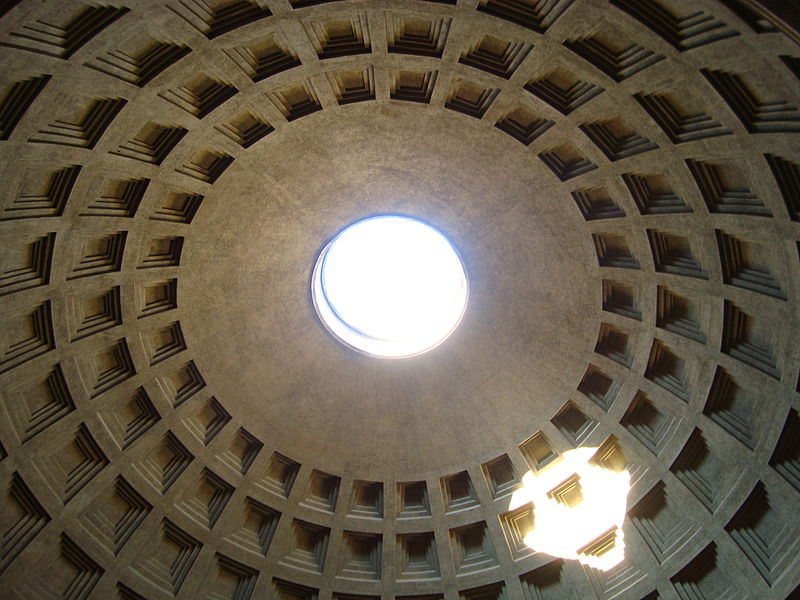
Cromleque de Almendres in Sagittarius with Gemini.

The “Cromeleque (stone círcle) of Almendres” near Evora,Portugal is a megaltihic sun and star observatory, temple and gathering site built and used from around 5000 to 2800 BCE. It consists of 96 standing stones of different origin but none of them at the site itself.
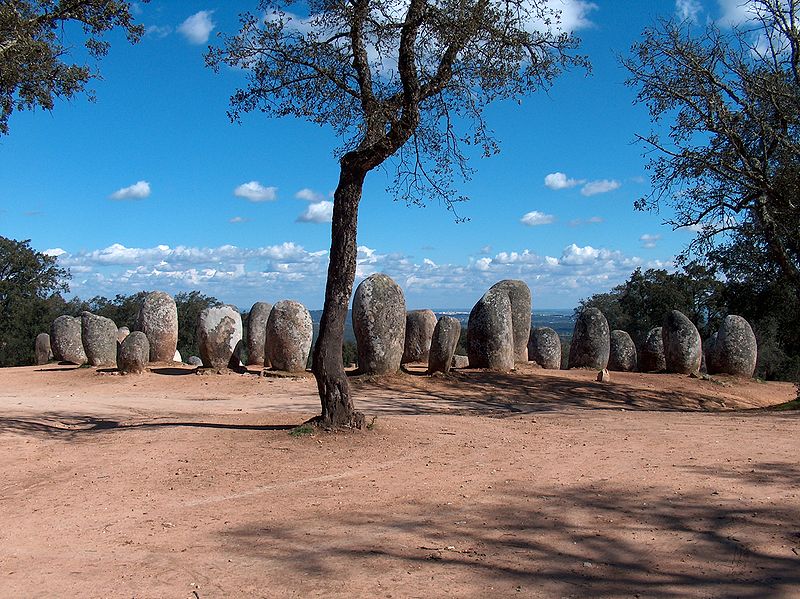
Astrogeographical position according to my Astrological World Map calculation system for field level 4 (exact position – ca. 80 x 100 m size of fields):
- One coordinate of the site is located in fire sign Sagittarius sign of circles, observation, thinking, science, time and direction measurement, shamanism, priest castes, healing, ritual worship
- The 2nd coordinates stretches between solid fixed earth sign Taurus sign of the earth, food, agriculture, possession of land, local market centers and air sign Gemini sign of technological progress and learning, schools, road crossings, exchange of information, language and signposts.
- The position between Taurus (food production) and Gemini (indicates the function of the stone circle for determination of important agricultural dates like for sowing, planting and harvesting as well as a temple of ritual worship related to agriculture.
Pachataka or Horca del Inca in Sagittarius with Pisces
Another example for an ancient sun observatory located in Sagittarius is the Pachat’aqa or Horca del Inca in Bolivia dated 1800 BC. The astrogeographical resonance coordinates of the site are located in the sign combination Sagittarius with Pisces.
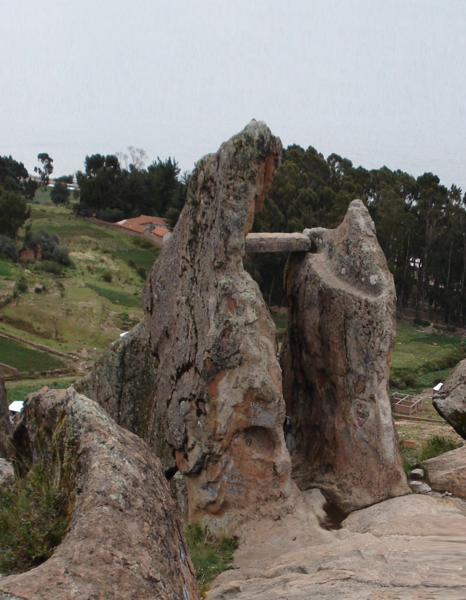
author: Giovo95 jduranboger, ccbysa3.0
Mên-an-Tol in Sagittarius with Gemini
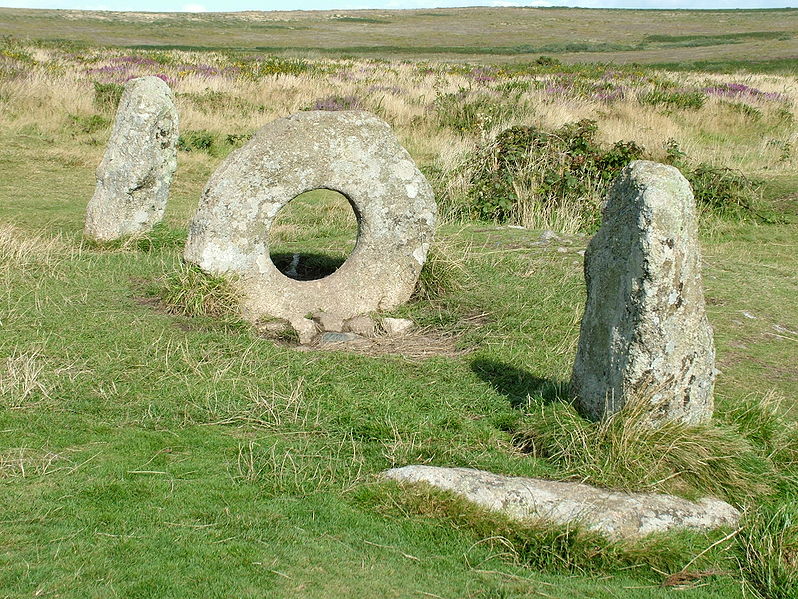
Mên-an-Tol is a small megalithical installation of standing stones about 5 km northeast of Penzance in Cornwall. The place is located in the same constellation as the Sonehenge circle but for radius level 4 which is easily explained by the difference in size and significance. All three air signs (Libra, Gemini, Aquarius) signs often stand for openings (open spaces) in rocks. Compare: Chartreuse Arch, Arches National Park, Benagil Cave, Glory Hole Ozark, Devil`s Bridge.
Gemini is typical for places of learning, teaching and passing information while Sagitarius the sign of shamanism stands for initiation rites and also for time measurement. Sagittarius the sign of design and ornamentation is typical for the round form of the carved stone. Because of it`s meaning for time measurement it is highly probable that the installation has been used for measuring the seasons and equinoxes and maybe also the daytime.
“American Stonehenge” in Sagittarius – Gemini
“America’s Stonehenge” is a privately owned tourist attraction and archaeological site consisting of a number of large rocks and stone structures scattered around roughly 30 acres……..Archaeologist David Starbuck has said: “It is widely believed that Goodwin may have ‘created’ much of what is visible at the site today.” (from: wikipedia article)

The so called “America`s Stonehenge” in Salem, New Hampshire can hardly be compared nor to the original Stonehenge in Wiltshire, UK.
But surprisingly the site is located in the same astrogeographical constellation of the shamanistic fire sign Sagittarius with air sign Gemini the sign of signposts for morphogenetic field level 3.
This parallel and resonance explains the name transfer (quote) from the English Stonehenge.